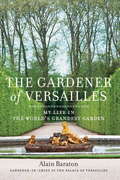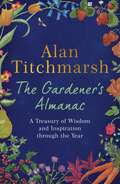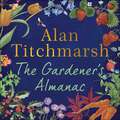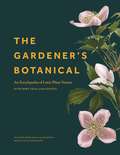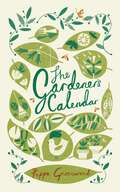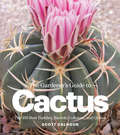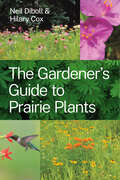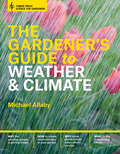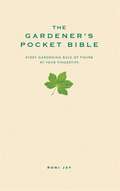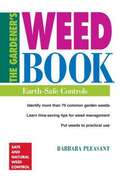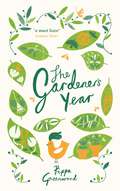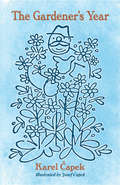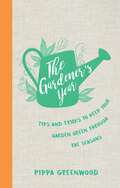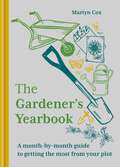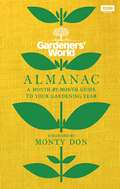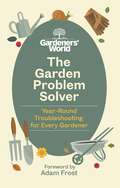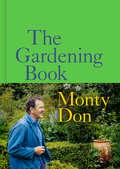- Table View
- List View
The Gardener of Alcatraz: A True Story
by Emma Bland SmithA prisoner gardens his way to freedom in this inspiring picture-book biography.When Elliott Michener was locked away in Alcatraz for counterfeiting, he was determined to defy the odds and bust out. But when he got a job tending the prison garden, a funny thing happened. He found new interests and skills--and a sense of dignity and fulfillment. Elliott transformed Alcatraz Island, and the island transformed him. Told with empathy and a storyteller's flair, Elliott's story is funny, touching, and unexpectedly relevant. Back matter about the history of Alcatraz and the US prison system today invites meaningful discussion.
The Gardener of Versailles
by Alain Baraton Christopher Brent MurrayFor gardening aficionados and Francophiles, a love letter to the Versailles Palace and grounds, from the man who knows them best. In Alain Baraton's Versailles, every grove tells a story. As the gardener-in-chief, Baraton lives on its grounds, and since 1982 he has devoted his life to the gardens, orchards, and fields that were loved by France's kings and queens as much as the palace itself. His memoir captures the essence of the connection between gardeners and the earth they tend, no matter how humble or grand.With the charm of a natural storyteller, Baraton weaves his own path as a gardener with the life of the Versailles grounds, and his role overseeing its team of eighty gardeners tending to 350,000 trees and thirty miles of walkways on 2,100 acres. He richly evokes this legendary place and the history it has witnessed but also its quieter side that he feels privileged to know. The same gardens that hosted the lavish lawn parties of Louis XIV and the momentous meeting between Marie Antoinette and the Cardinal de Rohan remain enchanted, private places where visitors try to get themselves locked in at night, lovers go looking for secluded hideaways, and elegant grandmothers secretly make cuttings to take back to their own gardens. A tremendous best seller in France, The Gardener of Versailles gives an unprecedentedly intimate view of one of the grandest places on earth.
The Gardener's Almanac: A Treasury of Wisdom and Inspiration through the Year
by Alan TitchmarshNational treasure and presenter of ITV's hugely popular Love Your Garden, Alan Titchmarsh brings us his month by month almanac of garden knowledge, facts, advice and inspiration. Here is seasonal advice on what to grow and sow, projects to engage in, as well as wildlife to spot, gorgeous gardens to visit, birds and flowers to celebrate, weather notes, and nature to reflect on in poems, music, and books. A beautifully packaged giftbook with illustrations by Alan himself.
The Gardener's Almanac: A Treasury of Wisdom and Inspiration through the Year
by Alan TitchmarshNational treasure and presenter of ITV's hugely popular Love Your Garden, Alan Titchmarsh brings us his month by month almanac of garden knowledge, facts, advice and inspiration. Here is seasonal advice on what to grow and sow, projects to engage in, as well as wildlife to spot, gorgeous gardens to visit, birds and flowers to celebrate, weather notes, and nature to reflect on in poems, music, and books. A beautifully packaged giftbook with illustrations by Alan himself.
The Gardener's Almanac: A Treasury of Wisdom and Inspiration through the Year
by Alan TitchmarshA month by month treasury of gardening advice, inspiration and knowledge from the nation's favourite gardener.National treasure and presenter of ITV's hugely popular Love Your Garden, Alan Titchmarsh brings us his month by month almanac of garden knowledge, facts, advice and inspiration. Here is seasonal advice on what to grow and sow, projects to engage in, as well as wildlife to spot, gorgeous gardens to visit, birds and flowers to celebrate, weather notes, and nature to reflect on in poems, music, and books.(P) 2022 Hodder & Stoughton Limited
The Gardener's Botanical: An Encyclopedia of Latin Plant Names - with More than 5,000 Entries
by The Gardener's B Ross BaytonThe definitive guide to botanical Latin. Unlock the secrets of botanical Latin with this beautifully illustrated encyclopedia. The Gardener's Botanical contains definitions of more than 5,000 plant names—from abbreviatus ("shortened") to zonatus ("with bands")—along with more than 350 color illustrations. Scientific plant names are an invaluable tool for those who understand them. Formed from Greek and, more commonly, from Latin root words, not only do they make it possible for gardeners and botanists to communicate, they also contain a wealth of hidden information. The Gardener's Botanical is the key to unlocking these secrets. This guide contains a breathtaking array of botanical names in alphabetical order. Each word is listed with a pronunciation guide, definition, example plant, and, where appropriate, etymology. Also included in this illuminating guide are special features on important plant genera, fact boxes, essays focusing on the history and importance of Latin names and botanical illustrations, and an index of common names with more than 2,000 popular plants, cross-referenced with their binomial name in Latin.
The Gardener's Calendar
by Pippa GreenwoodThis beautifully illustrated guide contains month-by-month ‘to do’ lists for ornamental gardens, edible crops and general maintenance. Award-winning writer Pippa Greenwood presented BBC Two’s Gardeners’ World for over 13 years and she is a regular panellist on Radio 4’s Gardeners’ Question Time.
The Gardener's Calendar
by Pippa GreenwoodThis beautifully illustrated guide contains month-by-month ‘to do’ lists for ornamental gardens, edible crops and general maintenance. Award-winning writer Pippa Greenwood presented BBC Two’s Gardeners’ World for over 13 years and she is a regular panellist on Radio 4’s Gardeners’ Question Time.
The Gardener's Guide to Cactus: The 100 Best Paddles, Barrels, Columns, and Globes
by Scott CalhounWhen it comes to garden plants, cacti are anything but standard issue. The bulk of home gardens contain exactly zero species of cactus, and the thought of growing them makes gardeners think, “Ouch!” In The Gardener’s Guide to Cactus: The 100 Best Paddles, Barrels, Columns, and Globes, Scott Calhoun is out to change that perception, and bring the beauty and ease of cactus home. It’s high time that cacti took their place alongside the trendy succulent.
The Gardener's Guide to Prairie Plants (Emersion: Emergent Village Resources For Communities Of Faith Ser.)
by Neil Diboll Hilary CoxA comprehensive and beautifully illustrated reference for all gardeners passionate about native plants and prairie restoration. The Gardener’s Guide to Prairie Plants is the one-stop compendium for all gardeners aspiring to use native prairie plants in their gardens. Neil Diboll and Hilary Cox—two renowned prairie gardeners—compile more than four decades’ worth of research to offer a wide-ranging and definitive reference for starting and maintaining prairie and meadow gardens and restorations. Alongside detailed synopses of plant life cycles, meticulous range maps, and sweeping overviews of natural history, Diboll and Cox also include photographs of 148 prairie plants in every stage of development, from seedling to seedhead. North America’s grasslands once stretched from the Blue Ridge to the Rocky Mountains, and from Texas to Manitoba, blanketing the mid-continent with ecologically important, garden-worthy, native species. This book provides all the inspiration and information necessary for eager native planters from across the country to welcome these plants back to their landscapes. The Gardener’s Guide to Prairie Plants is a must-have reference for gardeners, restorationists, and every flora fan with a passion for native plants, prairies and meadows.
The Gardener's Guide to Prairie Plants (Emersion: Emergent Village Resources For Communities Of Faith Ser.)
by Neil Diboll Hilary CoxA comprehensive and beautifully illustrated reference for all gardeners passionate about native plants and prairie restoration. The Gardener’s Guide to Prairie Plants is the one-stop compendium for all gardeners aspiring to use native prairie plants in their gardens. Neil Diboll and Hilary Cox—two renowned prairie gardeners—compile more than four decades’ worth of research to offer a wide-ranging and definitive reference for starting and maintaining prairie and meadow gardens and restorations. Alongside detailed synopses of plant life cycles, meticulous range maps, and sweeping overviews of natural history, Diboll and Cox also include photographs of 148 prairie plants in every stage of development, from seedling to seedhead. North America’s grasslands once stretched from the Blue Ridge to the Rocky Mountains, and from Texas to Manitoba, blanketing the mid-continent with ecologically important, garden-worthy, native species. This book provides all the inspiration and information necessary for eager native planters from across the country to welcome these plants back to their landscapes. The Gardener’s Guide to Prairie Plants is a must-have reference for gardeners, restorationists, and every flora fan with a passion for native plants, prairies and meadows.
The Gardener's Guide to Weather and Climate: How to Understand the Weather and Make It Work for You (Science For Gardeners Ser.)
by Michael Allaby“We owe it to our plants to read this book. After all, while we just live with the weather, our plants have to survive it.” —The Washington Post All gardeners are at the whim of Mother Nature, and so are our plants. Whether it’s coping with extreme drought or record-breaking snow fall, gardeners—and gardens—across the country are fighting against the elements. Instead of just reacting to the weather, Michael Allaby suggests that gardeners use knowledge about how the weather works to create the best growing conditions for their plants. Allaby brings big-picture atmospheric concepts to life with a comprehensive introduction to how weather works and explanations climate change, weather systems, and microclimates. The Gardener’s Guide to Weather and Climate proves that instead of gardening at the mercy of the weather, knowledgeable gardeners can make the weather work for them
The Gardener's Pocket Bible: Every gardening rule of thumb at your fingertips
by Roni JayDo you know every gardening technique and rule of thumb off pat? Or do you occasionally straighten up from your digging to try and remember exactly what you're meant to be doing? How deep should you plant these bulbs? Was it now you were supposed to prune this rose, or in February? Can you compost this weed? Is it OK to plant out these seedlings now? It's such a pain having to go indoors, kick off your boots, shed your outdoor clothes and start looking up the answer to your question in some great gardening tome. And that's where The Gardener's Pocket Bible comes in. Now, you can stay in the garden and look up all those essential facts and figures in an instant. At your fingertips you'll have all the answers to your on-the-spot questions such as: Which plants do you need to protect from frost? When should you cut the hedge? What plants need staking, and when? How can you get rid of greenfly without using pesticides? This indispensible little guide will tell you what you need to know, when you need to know it - and will save you thumbing through gardening encyclopedias when what you actually want to do is get on with the gardening.This beautiful hardback edition has both dust-cover and gold embossing on the spine making it the perfect gift. Every Pocket Bible is lovingly crafted to give you a unique mix of useful references, handy tips and fascinating trivia that will enlighten and entertain you at every page. There is a Pocket Bible for everyone...Other titles in the series: The Outdoor Pocket Bible, The Camping Pocket Bible, The London Pocket Bible, The Camping Pocket Bible and The Railway Pocket Bible.
The Gardener's Pocket Bible: Every gardening rule of thumb at your fingertips
by Roni JayDo you know every gardening technique and rule of thumb off pat? Or do you occasionally straighten up from your digging to try and remember exactly what you're meant to be doing? How deep should you plant these bulbs? Was it now you were supposed to prune this rose, or in February? Can you compost this weed? Is it OK to plant out these seedlings now? It's such a pain having to go indoors, kick off your boots, shed your outdoor clothes and start looking up the answer to your question in some great gardening tome. And that's where The Gardener's Pocket Bible comes in. Now, you can stay in the garden and look up all those essential facts and figures in an instant. At your fingertips you'll have all the answers to your on-the-spot questions such as: Which plants do you need to protect from frost? When should you cut the hedge? What plants need staking, and when? How can you get rid of greenfly without using pesticides? This indispensible little guide will tell you what you need to know, when you need to know it - and will save you thumbing through gardening encyclopedias when what you actually want to do is get on with the gardening.This beautiful hardback edition has both dust-cover and gold embossing on the spine making it the perfect gift. Every Pocket Bible is lovingly crafted to give you a unique mix of useful references, handy tips and fascinating trivia that will enlighten and entertain you at every page. There is a Pocket Bible for everyone...Other titles in the series: The Outdoor Pocket Bible, The Camping Pocket Bible, The London Pocket Bible, The Camping Pocket Bible and The Railway Pocket Bible.
The Gardener's Weed Book: Earth-Safe Controls
by Barbara Pleasant Pamela LappiesBeginning and expert gardeners will learn how to identify and control weeds using earth-safe methods.
The Gardener's Year
by Pippa GreenwoodThis beautifully illustrated guide contains specific month-by-month ‘to do’ lists for ornamental gardens, edible crops and general maintenance, as well as tips on things to look out for, such as pests and how to eliminate them.
The Gardener's Year
by Pippa GreenwoodThis beautifully illustrated guide contains specific month-by-month ‘to do’ lists for ornamental gardens, edible crops and general maintenance, as well as tips on things to look out for, such as pests and how to eliminate them.
The Gardener's Year (Modern Library Gardening Ser.)
by Karel Capek Josef CapekThe creator of this book is best known internationally as the author of R.U.R., the science-fiction play that introduced the term "robot" to the world. Karel Čapek's satiric gifts take a different turn in this impishly comic book, which recounts the trials, labors, joys, and meditations of the amateur gardener.Rather than a how-to book, Čapek's volume offers a lighthearted mock-treatise on the pains and rewards of tending a small and resistant garden plot. From January to December, the author and his brother, illustrator Josef Čapek, trace the vagaries of the amateur horticulturist's year, with brief side notes on seeds, the soil, plants, the beauties of autumn, and other aspects of gardening. Fifty-nine delightful drawings complement this book, which will amuse readers with and without green thumbs.
The Gardener's Year: Tips and Tricks to Keep Your Garden Green Through the Seasons
by Pippa GreenwoodThis charming and indispensable reference guide contains specific month-by-month ‘to do’ lists for ornamental gardens, edible crops and general maintenance, as well as tips on everything green-fingered, from protecting your plants from frost, pests and disease to making sure you get a bumper harvest to enjoy year-round. With diary pages for making your own notes each month, this pocket-sized yearbook is a must-have for every season. Whether you’re a seasoned gardener or just starting out, this book will become an old and trusted friend.
The Gardener's Yearbook: A month-by-month guide to getting the most out of your plot
by Martyn Cox'An experienced horticulturist's monthly guide to gardening, with wise, clear and helpful advice on tackling the essential tasks and dealing with problems.' Gardens IllustratedOne of the keys to happy gardening is knowing what to do and when for the best results. In this handy guide, experienced horticulturist Martyn Cox takes you through the gardening year, month by month, offering wise, clear and helpful advice on the essential tasks and how to avoid problems along the way.No matter the size of the plot, nor the expertise of the gardener, The Gardener's Yearbook is the perfect handbook to return to throughout the seasons, with tips including:- How to get your lawn into shape for the summer- When you should plant lilies, roses and sweet peas- How and when to harvest and store your fruit and vegetables- When to prepare containers for winter- How to fit a water butt and start a compost bin- An easy-to-follow crop plannerFeaturing specially commissioned linocuts by artist Heather Tempest-Elliott.
The Gardener's Yearbook: A month-by-month guide to getting the most out of your plot
by Martyn Cox'An experienced horticulturist's monthly guide to gardening, with wise, clear and helpful advice on tackling the essential tasks and dealing with problems.' Gardens IllustratedOne of the keys to happy gardening is knowing what to do and when for the best results. In this handy guide, experienced horticulturist Martyn Cox takes you through the gardening year, month by month, offering wise, clear and helpful advice on the essential tasks and how to avoid problems along the way.No matter the size of the plot, nor the expertise of the gardener, The Gardener's Yearbook is the perfect handbook to return to throughout the seasons, with tips including:- How to get your lawn into shape for the summer- When you should plant lilies, roses and sweet peas- How and when to harvest and store your fruit and vegetables- When to prepare containers for winter- How to fit a water butt and start a compost bin- An easy-to-follow crop plannerFeaturing specially commissioned linocuts by artist Heather Tempest-Elliott.
The Gardeners' World Puzzle Book
by Gardeners' World Magazine100 horticultural head-scratchers to test your botanical brain powerCan you tell Myosotis from Magnolia? Can you tell your beeches from your birches?Featuring 100 puzzles including crosswords, word searches, anagrams, word wheels and code breakers, The Gardeners’ World Puzzle Book has everything you need to unwind from a long day in the garden while sharpening your mind at the same time.Organised by season and difficulty, this fun and beautiful book offers everything from easy breezy brainteasers to the thorniest of horticultural headscratchers – the perfect companion for any grower!
The Gardeners’ World Almanac: A month-by-month guide to your gardening year
by Gardeners' World MagazineThe team at Gardeners' World bring you the ultimate guide to your gardening year, from planning and planting to troubleshooting tips and gardening discovery. Organised by month, this book includes lists, timetables, step-by-step guidance and expert advice for year-round gardening, as well as an informative guide on what to plant when and projects for every season. Complemented by beautiful hand-drawn illustrations and tips from your favourite gardening personalities, The Gardeners' World Almanac will help you make your garden look its very best throughout the year.
The Gardeners’ World Problem Solver: Year-Round Troubleshooting for Every Gardener
by Adam Frost BBC Gardeners’ World MagazineEven with the best planning and care, every garden can run into a problem or two. Whether you are beset with beetles or blighted by blackspot, The Garden Problem Solver has the solution.Guided by the team of experts at Gardeners' World - including advice from Monty Don, Alan Titchmarsh, Carol Klein, Arit Anderson, Adam Frost and more - The Garden Problem Solver contains the practical tips, tricks and techniques to deal with the obstacles that every home gardener has to face.Broken down into easy-to-follow steps, this handy guide will help you anticipate, avoid and troubleshoot the most common garden problems which crop up when growing your favourite fruit, veg, flowers and more.With a foreword by Adam Frost and complemented with hand-drawn illustrations, The Garden Problem Solver holds the secrets to making your garden look its very best.
The Gardening Book: An Accessible Guide to Growing Houseplants, Flowers, and Vegetables for Your Ideal Garden
by Monty DonA fresh approach to gardening by bestselling author and England&’s favorite gardener Monty Don.&“Think of your garden like a meal. When you select a recipe, you&’re choosing it based on inclination, experience and circumstance. Making a garden, big or small, uses exactly the same process.&”If you are new to gardening, it can seem daunting—with Latin names, various soil types and seasonal requirements, it feels like a lot to learn. But with Monty Don&’s new book as a guide you will discover just how joyful and rewarding gardening can be.Whether you want to grow your own vegetables, create a child-friendly garden, connect with nature, or make the most of houseplants, Monty will help you unlock your space&’s potential, showing you what, where and when to plant. The Gardening Book gives you the basics to grow over 100 popular flowers, foods, shrubs, houseplants and more—each one has a clear, concise, format: what you need, timing, method, and step-by-step photos, all on one spread. It&’s a refreshingly accessible approach that will help you build a garden which best serves your needs and enhances your lifestyle.

